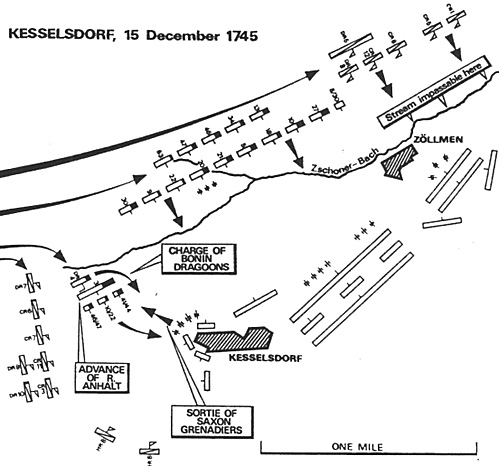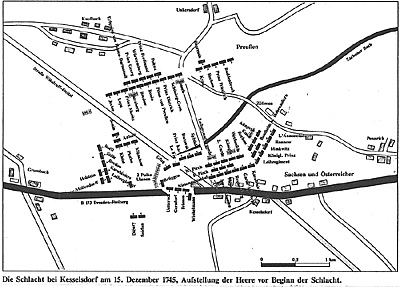 The Battle Begins
The Battle Begins
The Prussian army left its encampments between Rohrsdorf and Naustadt at 7:30 AM on the 15th of December. They formed four march columns and advanced on Wilsdruff. The light horse of the Prussians encountered the Saxon ulans in a series of skirmishes during this advance, finally coming under artillery fire from the battery at Kesselsdorf.
MAP 1 : Depicts Leopold's approach march from west to east as well as the subsequent deployment and attack of the Saxon left flank near Kesselsdorf. Map courtesy of Christopher Duffy.
The Prussian columns continued their advance south of Kaufbach in spite of the difficulties encountered crossing the smooth expanses of frozen snow. The Saxons admired a fine view of the rapid deployment of the Prussian forces.
Although the Prussian heavy artillery was unable to keep up with the army, Leopold decided an attack was in order due to the lateness in the all too short winter day. Thus he ordered an attack at about 2 PM. He is reputed to have urged on the battalions of Kleist, Plotho, Munchow, and his own regiment Anhalt by proclaiming, "Dear God, stand mercifully by us today, or, if you do not want to stand by me at this time, then at least do not also help the enemy scoundrel, but see what happens." It is certain that with a cry of "In Jesus name, march." he began the attack.
The grenadiers led the attack with scorn for the Saxon fire, keeping their muskets shouldered, under the command of General Herzberg. The decline was so slick that the grenadiers had to lean on each other to keep from slipping. By the time their own artillery arrived, the grenadier battalions were so thinned by enemy fire that their brave efforts came to a standstill.
The Anhalt regiment swept through their ranks with one flank and proceeded to return fire under the urging of their feared sergeants. Herzberg was able to urge them to the edge of the village, but the Saxon Grenadiers (some of whom had already expended 20 cartridges) stood fast and continued to thin the Prussian ranks with their fire. Finally Herzberg fell and then the remainder of his battalions sought shelter behind a ground swell. In the space of an hour they had lost 33 officers 1298 killed and wounded of the 3600 men they had started with. Anhalt alone had lost 500 men.
The Saxons Counterattack
Encouraged by this event, the grenadiers of the Saxon regiments Gfug and Le Fee jumped over the works and were led to the assault by General Wilster. Upon reaching the Prussian train, however, they stopped for plunder. On seeing this, Leopold ordered the Bonin dragoons to charge. Under Colonel Luderitz the regiment sprang into an extended gallop. The grenadiers could not sustain this determined cavalry attack -as they did not have the support of the large battery in the village as its fire could not reach there. They were ridden down in disarray.
During this cavalry attack Leopold advanced the remainder of his infantry. The right wing advanced with flags flying against the three Saxon chevauleger regiments entrusted with protecting the large battery on the high ground between Kesselsdorf and Zollmen. These regiments could not withstand the fire of the Prussian infantry and, in their retreat, disordered the left wing of the Saxon army. The regiment Jeetze, moving behind the meadows on the route KesselsdorfUnkersdorf, was able to surprise this battery and army wing by appearing at right angles to their line. This allowed them to penetrate into the village while capturing 24 guns, 1 flag, and 1 pair of kettledrums.
Although the Saxon general Allnpeck ordered the 1 battalion each of Winkelmann and Nikolaus Pirch to reinforce the village, the Prussian inexorably advancing from the west and north, the shreds of the artillery in retreat, and the village burning adding to the confusion, the Saxons began to retreat. Allnpeck was captured and the village of Kesselsdorf, the mainstay of the allied position, was lost to the Prussians.
 The Battle In The Center
The Battle In The Center
In the meantime, the left wing of the Prussians under the command of Prince Moritz of Anhalt had advanced to the Zschoner brook. Since the ice was breaking under the Prussians, Moritz jumped from his horse and was carried across by two musketeers. Reforming on the other side, the Prussians began to climb the slippery slope directly south of Zollmen. On closing they received devastating cannister and musketry fire from the Saxons. Prince Moritz, with the regiment Prince of Prussia, threw himself on the Saxon line.
Kesseldorf Jumbo Map (slow: 166K)
The Saxon cavalry countercharged through the thinning ranks of its own infantry, and almost succeeded in stopping the Prussian advance when the Prussian regiments Prince Ferdinand and Polenz appeared and rebuffed the cavalry with a volley. Thus the allied center was penetrated.
As Prince Moritz's center advanced, Rutowski ordered the allied left wing to make an advance. The generals Diemar and Jasmund led the regiments Konigin, II Garde, Leibgrenadiers, Franz Pirch, and the second battalion of Nikolaus Pirch in this counterattack. However, it was already threatened by the Prussian infantry breaking through from Kesselsdorf on its left flank.
The allied commanders, notably the Duke of Weissenfals hurried up from Dresden by the rumbling of the guns and Graf Rutowski the Knight of Saxony, tried to rally the retreating soldiers. However, the Prussian guns finally in action on the high plain, and the Prussian infantry fire made this impossible. The fire from 3 to 4 Prussian battalions had broken 50 squadrons of Saxon horse and led to a rout that would not be stopped before nightfall. The Prussian horse of the right wing had entered Kesselsdorf in spite of the difficulty of the defiles and had begun to deploy behind the left wing. The Saxons were put in full rout by the regiment Roell and one standard was captured here. Only darkness put an end to the pursuit by the hussar regiments Dieury and Soldan.
The Saxon foot did not fare any better. General Jasmund tried to push back the Prussian infantry issuing from Kesselsdorf with the left wing battalions. When General Neubar fell his battalions stopped their advance and surrendered. Jasmund barely made it out of the closing jaws with about 800 men. Most of the Saxon infantry was finally collected at the Weiseritz, but the cavalry fled all the way to the Grosse Garten in Dresden.
The allied right wing between Pennrich and Zolimen fared somewhat better. The Prussian attack here suffered heavy casualties from the fire of the heavy Saxon battery at Zolimen. Supported by this fire the Saxons forced the Prussian advance to halt. Finally in bunches of 30 to 60 men the Prussians were able to close with the Saxon line. Even an attack by the Saxon cuirassier regiment l'Annonciade could not save the day as it was stopped by the Prussian fire. General Haxthausen finally led this wing, in good order, back to Dresden.
This battle had been decided in less than two hours of fighting. The only Saxon corps to remain was the corps of Grunne, whose assistance in the fight Rutowski had vainly asked for. Forgetting both friend and enemy on the battlefield, this corps went to Dresden to join with Prince Charles.
The Prussian casualty list included 34 officers and 1570 corporals and soldiers dead, 90 officers and 3068 corporals and soldiers wounded. The Saxon losses were 3810 men including 58 officers, almost all from Saxony. They also lost 48 guns, 6 flags, 2 standards, and 1 pair of kettledrums.
On the night of the 16th, the Prussian captain Oelsnitz delivered the news to Frederick. On the 17th the two Prussian forces joined giving Frederick some 83,000 men, who immediately advanced on Dresden. Prince Charles offered to attack the Prussians with the combined allied army, but was dissuaded from doing so by Rutowski who pleaded the temporary unbattleworthiness of his troops.
Cessation of hostilities occurred in Saxony on the 24th and in Silesia on the 28th of December. The Prussian troops began their withdrawal from Saxon soil. Maria Theresa was forced to confirm explicitly the Breslauer peace which gave Silesia to Frederick. In return, Franz Stephan, (who was the Duke of Tuscany and her husband), was acknowledged as Holy Roman Emperor.
The Prussians forcibly enrolled 1600 Saxon militia from Dresden into their army. Leopold died in 1747 so this was his last battle.
Bibliography
Osterreichs Schlachtfelder by Arnold Preil
The Army of Frederick the Great by Christopher Duffy
The Army of Maria Theresa by Christopher Duffy
The Encyclopedia of Military History by R. Ernest Dupuy and Trevor N. Dupuy
Battle of Kesseldorf
Back to Seven Years War Asso. Journal Vol. VII No. 1 Table of Contents
Back to Seven Years War Asso. Journal List of Issues
Back to Master Magazine List
© Copyright 1993 by James Mitchell
This article appears in MagWeb.com (Magazine Web) on the Internet World Wide Web.
Other articles from military history and related magazines are available at http://www.magweb.com